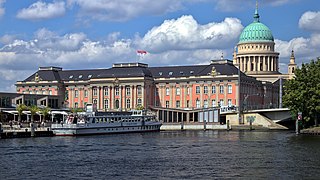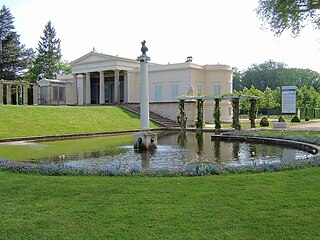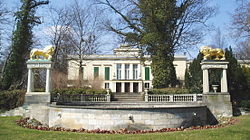
Potsdam is the capital and largest city of the German state of Brandenburg. It is part of the Berlin/Brandenburg Metropolitan Region. Potsdam sits on the River Havel, a tributary of the Elbe, downstream of Berlin, and lies embedded in a hilly morainic landscape dotted with many lakes, around 20 of which are located within Potsdam's city limits. It lies some 25 kilometres southwest of Berlin's city centre. The name of the city and of many of its boroughs are of Slavic origin.

Karl Friedrich Schinkel was a Prussian architect, city planner and painter who also designed furniture and stage sets. Schinkel was one of the most prominent architects of Germany and designed both Neoclassical and neo-Gothic buildings. His most famous buildings are found in and around Berlin.

Wannsee is a locality in the southwestern Berlin borough of Steglitz-Zehlendorf, Germany. It is the westernmost locality of Berlin. In the quarter there are two lakes, the larger Großer Wannsee and the Kleiner Wannsee, located on the River Havel and separated only by the Wannsee Bridge. The larger of the two lakes covers an area of 2.7 km2 (1.0 sq mi) and has a maximum depth of 9 m (30 ft).

Cecilienhof Palace is a palace in Potsdam, Brandenburg, Germany, built from 1914 to 1917 in the layout of an English Tudor manor house. Cecilienhof was the last palace built by the House of Hohenzollern that ruled the Kingdom of Prussia and the German Empire, until the end of World War I. It is famous for having been the location of the Potsdam Conference in 1945, in which the leaders of the Soviet Union, the United Kingdom and the United States made important decisions affecting the shape of post-World War II Europe and Asia. Cecilienhof has been part of the Palaces and Parks of Potsdam and Berlin UNESCO World Heritage Site, since 1990.

Schloss Charlottenburg is a Baroque palace in Berlin, located in Charlottenburg, a district of the Charlottenburg-Wilmersdorf borough, and is among the largest palaces in the world.

Friedrich Ludwig Persius was a Prussian architect and a student of Karl Friedrich Schinkel.

The Roman Baths, situated northeast of the Charlottenhof Palace in the Sanssouci Park in Potsdam, reflect the Italiensehnsucht of its creator Frederick William IV of Prussia. Various classical Roman and antique Italian styles were melded into an architectural ensemble, created between 1829 and 1840.

Ss. Peter and Paul Church on Nikolskoë is a Protestant church in the Volkspark Glienecke in Berlin, Germany. It is currently administered by the Evangelical Church of Berlin-Brandenburg-Silesian Upper Lusatia. The church is part of the UNESCO World Heritage Site Palaces and Parks of Potsdam and Berlin.

Charlottenhof Palace or Charlottenhof Manor is a former royal palace located southwest of Sanssouci Palace in Sanssouci Park at Potsdam, Germany. It is best known as the summer residence of Crown Prince Frederick William. Today it is maintained by the Prussian Palaces and Gardens Foundation Berlin-Brandenburg.

Peter Joseph Lenné was a Prussian gardener and landscape architect. As director general of the Royal Prussian palaces and parks in Potsdam and Berlin, his work shaped the development of 19th-century German garden design in the Neoclassical style. Laid out according to the principles of the English landscape garden, his parks are now World Heritage Sites.

Babelsberg is the largest quarter of Potsdam, the capital city of the German state of Brandenburg. The neighbourhood is named after a small hill on the Havel river. It is the location of Babelsberg Palace and Park, part of the Palaces and Parks of Potsdam and Berlin UNESCO World Heritage Site, as well as Babelsberg Studio, a historical centre of the German film industry and the first large-scale movie studio in the world.

Palaces and Parks of Potsdam and Berlin are a group of palace complexes and extended landscaped gardens located in the Havelland region around Potsdam and the German capital of Berlin. The term was used upon the designation of the cultural ensemble as a World Heritage Site by UNESCO in 1990. It was recognized for the historic unity of its landscape—a unique example of landscape design against the background of monarchic ideas of the Prussian state and common efforts of emancipation.

Jagdschloss Glienicke is a hunting lodge in the Berlin district of Wannsee near Glienicke Bridge. Babelsberg and Glienicke Palace can be seen nearby. Originally constructed in the late-17th century and expanded in the mid-1800s, the castle is part of the Palaces and Parks of Potsdam and Berlin UNESCO World Heritage Site, owing to its cohesion with the surrounding landscape and its testimony to the power of Prussia in the 17-19th centuries.

The Marmorpalais is a former royal residence in Potsdam, near Berlin in Germany, built on the grounds of the extensive Neuer Garten on the shores of the Heiliger See. The palace was commissioned by King Frederick William II of Prussia and designed in the early Neoclassical style by the architects Carl von Gontard and Carl Gotthard Langhans. Despite the name, brick is the main material. The palace remained in use by the Hohenzollern family until the early 20th century. It served as a military museum under communist rule, but has since been restored and is once again open to the public.

Villa Schöningen is a historic residence in the city of Potsdam, Germany, located at Berliner Straße 86 at the corner with Swan Avenue just west of the Glienicke Bridge, which leads to Berlin.

Babelsberg Park is a 114 hectare park in the northeast of the city of Potsdam, bordering on the Tiefen See lake on the River Havel. The park was first designed by the landscape artist Peter Joseph Lenné and, after him, by Prince Hermann von Pückler-Muskau and Karl Friedrich Schinkel, by order of the then-prince William I and his wife, Augusta. Located on a hill sloping down to the lake, the park and castle are part of the Palaces and Parks of Potsdam and Berlin, which were inscribed on the UNESCO World Heritage List because of their unique architecture and testimony to the development of landscape design.

Babelsberg Palace lies in the eponymous park and quarter of Potsdam, the capital of the German state of Brandenburg, near Berlin. For over 50 years it was the summer residence of Prince William, later German Emperor William I and King of Prussia and his wife, Augusta of the House of Saxe-Weimar-Eisenach, German Empress and Queen of Prussia. Along with the surrounding park and other parks in the area, the Babelsberg Palace was inscribed on the UNESCO World Heritage list in 1990 for its architectural cohesion and its testimony to the power of the Prussian monarchy.

Park Glienicke, is an English landscape garden in the southwestern outskirts of Berlin, Germany. It is located in the locality of Wannsee in the Steglitz-Zehlendorf borough. Close to Glienicke Bridge the park is open to the general public. The park is part of the UNESCO World Heritage Site Palaces and Parks of Potsdam and Berlin. Within the ensemble it is one of the five main parks, the others being Sanssouci Park, New Garden, Babelsberg Park and Peacock Island (Pfaueninsel). Regarding diversity in gardening styles within the Potsdam park ensemble Park Glienicke is only superseded by Sanssouci Park. Furthermore, it is a park especially characterized by one personality due to the intense involvement of Prince Charles of Prussia. The park covers approximately 116 hectares

Franz Joseph Oskar Ernst Patrick Friedrich Leopold Prinz von Preußen was a German art collector and dealer. During World War II, he was an inmate at Dachau concentration camp.

























